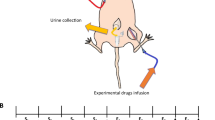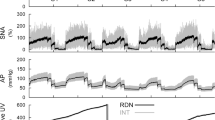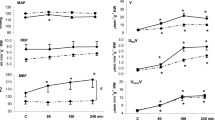Abstract
Background
Purine P2X and P2Y receptors (P2-R) are involved in control of renal circulation, especially in the medulla, wherein they appear to interact with angiotensin II (Ang II). Our experimental approach enabled examination of interaction with Ang II per se, in the absence of blood pressure elevation. In this whole-kidney functional study we focused on the influence of P2X1-R on perfusion of the renal medulla.
Methods
Acute experiments were conducted with normal rats, untreated or subjected to two weeks’ infusion of Ang II (osmotic minipumps). Urethane was used for anesthesia because in Ang II-treated rats it normalized elevated blood pressure. MRS2159, a P2X1-R inhibitor, was infused intravenously or directly into the medulla. Renal blood flow (RBF, Transonic renal artery probe), perfusion of the outer and inner medulla (OM-BF, IM-BF; laser-Doppler fluxes), and sodium and water excretion and urine osmolality (Uosm) were measured.
Results
In untreated rats intravenous MRS2159 unexpectedly decreased RBF by 12 ± 4% (p < 0.02) and IM-BF by 7 ± 2% (p < 0.05). In Ang II-pretreated rats the inhibitor tended to increase RBF while OM-BF and IM-BF increased 14 ± 5% and 12 ± 2%, respectively (p < 0.05 for both). Renal excretion was not affected, with or without Ang II treatment, while Uosm increased by about 150 mosmol/kg H2 O (p < 0.05). Intramedullary MRS2159 increased IM-BF only, by 21 ± 5% in untreated and 16 ± 3% in Ang II-treated rats (p < 0.04 for both).
Conclusions
Tonic activity of P2X1 receptors participates in control of renal medullary perfusion and of the tubular processes involved in urine concentration, neither effect is modified by Ang II pretreatment.
Similar content being viewed by others
References
Inscho EW. Renal microvascular effects of P2 receptor stimulation. Clin Exp Pharmacol Physiol 2001;28:332–9.
Nishiyama A, Rahman M, Inscho EW. Role of interstitial ATP and adenosine in the regulation of renal hemodynamics and microvascular function. Hypertens Res 2004;27:791–804.
Guan Z, Inscho EW. Role of adenosine 5′-triphosphate in regulating renal microvascular function and in hypertension. Hypertension 2011;58:333–40, doi:https://doi.org/10.1161/HYPERTENSIONAHA.110.155952.
Majid DS, Inscho EW, Navar LG. P2 purinoceptor saturation by adenosine triphosphate impairs renal autoregulation in dogs. J Am Soc Nephrol 1999;10:492–8.
Osmond DA, Inscho EW. P2X(1) receptor blockade inhibits whole kidney autoregulation of renal blood flow in vivo. Am J Physiol Renal Physiol 2010;298:F1360–8, doi:https://doi.org/10.1152/ajprenal.00016.2010.
Dobrowolski L, Walkowska A, Kompanowska-Jezierska E, Kuczeriszka M, Sadowski J. Effects of ATP on rat renal hemodynamics and excretion: role of sodium intake, nitric oxide and cytochrome P450. Acta Physiol (Oxf) 2007;189:77–85.
Chan CM, Unwin RJ, Bardini M, Oglesby IB, Ford A, Towsend-Nicholson A, et al. Localization of P2X1 purinoreceptors by autoradiography and immunohistochemistry in rat kidneys. Am J Physiol 1998;274:F799–804.
Inscho EW, Cook AK, Imig JD, Vial C, Evans RJ. Physiological role for P2X1 receptors in renal microvascular autoregulatory behavior. J Clin Invest 2003;112:1895–905.
Guan Z, Fuller BS, Yamamoto T, Cook AK, Pollock JS, Inscho EW. Pentosan polysulfate treatment preserves renal autoregulation in AngII-infused hypertensive rats via normalization of P2X1 receptor activation. Am J Physiol Renal Physiol 2010;298:F1276–84, doi:https://doi.org/10.1152/ajprenal.00743.2009.
Inscho EW, Cook AK, Clarke A, Zhang S, Guan Z. P2X receptor-mediated vasoconstriction of afferent arterioles in angiotensin II-infused hypertensive rats fed a high-salt diet. Hypertension 2011;57:780–7, doi:https://doi.org/10.1161/HYPERTENSIONAHA.110.168955.
Guan Z, Giddens MI, Osmond DA, Cook AK, Hobbs JL, Zhang S, et al. Immunosuppression preserves renal autoregulatory function and microvascular P2X(1) receptor reactivity in ANG II-hypertensive rats. Am J Physiol Renal Physiol 2013;304:F801–7, doi:https://doi.org/10.1152/ajprenal.00286.2012.
Franco M, Bautista R, Tapia E, Soto V, Santamaría J, Osorio H, et al. Contribution of renal purinergic receptors to renal vasoconstriction in angiotensin II-induced hypertensive rats. Am J Physiol Renal Physiol 2011;300: F1301–9.
Menzies RI, Unwin RJ, Bailey MA. Renal P2 receptors and hypertension. Acta Physiol (Oxf) 2015;213:232–41, doi:https://doi.org/10.1111/apha.12412.
Zhao X, Cook AK, Field M, Edwards B, Zhang S, Zhang Z, et al. Impaired Ca2+ signaling attenuates P2X receptor-mediated vasoconstriction of afferent arterioles in angiotensin II hypertension. Hypertension 2005;46:562–8.
Eppel GA, Ventura S, Evans RG. Regional vascular responses to ATP and ATP analogues in the rabbit kidney in vivo: roles for adenosine receptors and prostanoids. BrJ Pharmacol 2006; 149:523–31 PMID: 16981003.
Graciano ML, Nishiyama A, Jackson K, Seth DM, Ortiz RM, Prieto-Carrasquero MC, et al. Purinergic receptors contribute to early mesangial cell transformation and renal vessel hypertrophy during angiotensin II-induced hypertension. Am J Physiol Renal Physiol 2008;294:F161–9.
Bencze M, Behuliak M, Zicha J. The impact of four different classes of anesthetics on the mechanisms of blood pressure regulation in normotensive and spontaneously hypertensive rats. Physiol Res 2013;62:471–8 PMID: 24020816.
Cowley Jr. AW. Role of the renal medulla in volume and arterial pressure regulation. Am J Physiol 1997;273:R1–R15.
Seeliger E, Wronski T, Ladwig M, Dobrowolski L, Vogel T, Godes M, et al. The renin-angiotensin system and the third mechanism of renal blood flow autoregulation. Am J Physiol Renal Physiol 2009;296:F1334–45, doi: https://doi.org/10.1152/ajprenal.90476.2008.
Seeliger E, Becker K, Ladwig M, Wronski T, Persson PB, Flemming B. Up to 50-fold increase in urine viscosity with iso-osmolar contrast media in the rat. Radiology 2010;256:406–14, doi:https://doi.org/10.1148/radiol.10091485.
Yao Y, Hildreth CM, Farnham MM, Saha M, Sun QJ, Pilowsky PM, et al. The effect of losartan on differential reflex control of sympathetic nerve activity in chronic kidney disease. J Hypertens 2015;33:1249–60, doi:https://doi.org/10.1097/HJH.0000000000000535.
Dobrowolski L, Sadowski J. Renal medullary infusion of indomethacin and adenosine Effects on local blood flow, tissue ion content and renal excretion. Kidney Blood Press Res 2004;27:29–34.
Chin SY, Wang C-T, Majid DSA, Navar LG. Renoprotective effects of nitric oxide in angiotensin II-induced hypertension in the rat. Am J Physiol 1998;274:F876–82.
Inscho EW, Imig JD, Deichmann PC, Cook AK. Candesartan cilexetil protects against loss of autoregulatory efficiency in angiotensin II-infused rats. J Am Soc Nephrol 1999;10:S178–83.
Kim YC, Brown SG, Harden TK, Boyer JL, Dubyak G, King BF, et al. Structure-activity relationships of pyridoxal phosphate derivatives as potent and selective antagonists of P2X1 receptors. J Med Chem 2001;44:340–9.
Brown SG, King BF, Kim YC, Jang SY, Burnstock G, Jacobson KA. Activity of novel adenine nucleotide derivatives as agonists and antagonists at recombinant rat P2X receptors. Drug Dev Res 2000;49:253–9.
Sophocleous RA, Mullany PR, Winter KM, Marks DC, Sluyter R. Propensity of red blood cells to undergo P2X7 receptor-mediated phosphatidylserine exposure does not alter during in vivo or ex vivo aging. Transfusion 2015;55:1946–54, doi:https://doi.org/10.1111/trf.13101.
Lambrecht G. Agonists and antagonists acting at P2X receptors: selectivity profiles and functional implications. Naunyn Schmiedebergs Arch Pharmacol 2000;362:340–50.
Bohmann C, von Kügelgen I, Rump LC. P2-receptor modulation of noradrenergic neurotransmission in rat kidney. Br J Pharmacol 1997;121:1255–62, doi:https://doi.org/10.1038/sj.bjp.0701259.
Wang GF, Mao XJ, Chen ZJ. Urethane suppresses renal sympathetic nerve activity in Wistar rats. Eur Rev Med Pharmacol Sci 2014;18:1454–7 PMID: 24899602.
Kompanowska-Jezierska E, Walkowska A, Johns EJ, Sadowski J. Early effects of renal denervation in the anaesthetised rat: natriuresis and increased cortical blood flow. J Physiol 2001;531(2):527–34.
Menzies R, Howarth AR, Unwin RJ, Tam FWK, Mullins J, Bailey M. Inhibition of the purinergic P2X7 receptor improves renal perfusion in angiotensin-II-infused rats. Kidney Int 2015;88:1079–87, doi:https://doi.org/10.1038/ki.2015.182.
Dobrowolski L, Sadowski J. Furosemide-induced renal medullary hypoperfusion in the rat: role of tissue tonicity, prostaglandins and angiotensin II. J Physiol 2005;567:613–20.
Crawford C, Wildman SS, Kelly MC, Kennedy-Lydon TM, Peppiatt-Wildman CM. Sympathetic nerve-derived ATP regulates renal medullary vasa recta diameter via pericyte cells: a role for regulating medullary blood flow? Front Physiol 20134 (307), doi:https://doi.org/10.3389/fphys.2013.00307.
Oury C, Sticker E, Cornelissen H, De Vos R, Vermylen J, Hoylaerts MF. ATP augments von Willebrand factor-dependent shear-induced platelet aggregation through Ca2+-calmodulin and myosin light chain kinase activation. J Biol Chem 2004;279:26266–73.
Crawford C, Kennedy-Lydon TM, Callaghan H, Sprott C, Simmons RL, Sawbridge L, et al. Extracellular nucleotides affect pericyte-mediated regulation of rat in situ vasa recta diameter. Acta Physiol (Oxf) 2011;202(3):241–51, doi:https://doi.org/10.1111/j.1748-1716.2011.02310.x.
Nishiyama A, Majid DS, Taher KA, Miyatake A, Navar LG. Relation between renal interstitial ATP concentrations and autoregulation-mediated changes in renal vascular resistance. Circ Res 2000;86:656–62.
Nishiyama A, Jackson KE, Majid DS, Rahman M, Navar LG. Renal interstitial fluid ATP responses to arterial pressure and tubuloglomerular feedback activation during calcium channel blockade. Am J Physiol Heart Circ Physiol 2006;290:H772–7.
Wildman SS, King BF. P2X receptors: epithelial ion channels and regulators of salt and water transport. Nephron Physiol 2008;108:60–7, doi:https://doi.org/10.1159/000122028.
Marques RD, de Bruijn PI, Sorensen MV, Bleich M, Praetorius HA, Leipziger J. Basolateral P2X receptors mediate inhibition of NaCl transport in mouse medullary thick ascending limb (mTAL). Am J Physiol Renal Physiol 2012;302: F487–94, doi:https://doi.org/10.1152/ajprenal.00570.2011.
Silva GB, Garvin JL. Extracellular ATP inhibits transport in medullary thick ascending limbs: role of P2X receptors. Am J Physiol Renal Physiol 2009;297: F1168–73, doi:https://doi.org/10.1152/ajprenal.00570.2011.
Author information
Authors and Affiliations
Corresponding author
Additional information
Joint first authors.
Rights and permissions
About this article
Cite this article
Kuczeriszka, M., Dobrowolski, L., Walkowska, A. et al. Influence of P2X receptors on renal medullary circulation is not altered by angiotensin II pretreatment. Pharmacol. Rep 68, 1230–1236 (2016). https://doi.org/10.1016/j.pharep.2016.07.012
Received:
Revised:
Accepted:
Published:
Issue Date:
DOI: https://doi.org/10.1016/j.pharep.2016.07.012




